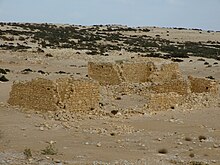Elusa (Haluza)
חלוצה - الخلصة | |
 | |
| Alternative name | Halasa Chellous al-Khalasa Elusa |
|---|---|
| Location | Southern District, Israel |
| Region | Negev |
| Coordinates | 31°05′49″N 34°39′07″E / 31.097°N 34.652°E |
| Type | Settlement |
| History | |
| Cultures | Nabataean, Roman |
| Site notes | |
| Condition | In ruins |
Europe and North America | |
The ancient city of Halasa or Chellous (
In the 5th century it was surrounded by vineyards and was famous for its wines.[1]
Due to its historic importance,
.Name in ancient sources
The city is called 'Chellous' (Χελλοὺς) in the
In
History
Nabataean period
The ancient site was founded by the
Late Roman and Byzantine periods
After the Roman annexation of Nabataea in 106 CE, Elusa grew to become the principal city of the central Negev, at the time part of the western Arabia Petraea province.[2]
Elusa became one of the first
Early in the fifth century, a bishop of Elusa, after redeeming the son of Nilus of Sinai, who had been carried off from Mount Sinai by the Arabs, ordained both him and his father.[10] Other bishops known are Theodulus, 431; Aretas, 451; Peter, 518; and Zenobius, 536.[11] The bishopric of Elusa still is included in the Catholic Church's list of titular sees.[12]
Early Muslim period
The
Western rediscovery, Bedouin resettlement
In 1838, Edward Robinson identified Al-Khalasa as the old Elusa based on its Arabic name.[2] In 1905, the Ecole Biblique of Jerusalem studied remains and discovered the cemetery of Elusa, and in 1914 C.L. Woolley and T. E. Lawrence (the soon-to-be "Lawrence of Arabia"), during their survey of the Negev, made an attempt of drawing a site plan, but could distinguish little more than traces of a wall and two gates.[2]
The constant interest of Western archaeologists in the remains of Elusa, encouraged the al-Azizma
Archaeology
The ruins of Halusa are located in a large plain 20 km (12 mi) southwest of Beersheba, Israel. Many inscriptions have been found there.[15]
In 2014, two archaeological survey-excavations were conducted at Haluza on behalf of the

A Greek inscription bearing the name of the city was discovered at Elusa, tentatively dated to the time of Emperor Diocletian around 300 CE. The announcement was made in March 2019 by the excavating German–Israeli team.[18]
Pre-Muslim decline
By analysing rubbish removed from the city, it has been determined that it underwent a major decline around the middle of the sixth century, about a century before the Islamic conquest.[19] The excavators propose that their findings call for a reevaluation of the settlement history of the Negev region in the late Byzantine period.[19] One possible cause for the crisis is raised as the Late Antique Little Ice Age, a cold snap believed to have been caused by "volcanic winter".[20]
Biblical association
According to a 1906 article from the ]
See also
References
- ^ a b Carta's Official Guide to Israel, 1983.
- ^ )
- ^ V:xv:10
- ^ In Isaiam V:xv, 4
- ^ Pratum Spirituale, clxiv
- ^ Rabbi Saadia Gaon's Judeo-Arabic Translation of the Pentateuch (Tafsir), s.v. Genesis 10:19, Genesis 20:2, Genesis 26:17, 20. On Haluza's proximity to Gerar, see: M. Naor, Gerar — Tell el Far'a, Bulletin of the Israel Exploration Society (1955), pp. 99–102 (Hebrew)
- ^ Negev (2001), p. 157. Source mis-names Zenobius as Libanius (a student of Zenobius).
- ^ "Vita Sancti Hilarionis", 25, in Patrologia Latina, XXIII, col.41
- ^ Jerome, loc.cit.
- ^ Patrologia Graeca LXXIX:373-93
- Lequien, Oriens Christianus III, 735
- ISBN 978-88-209-9070-1), p. 888
- ^ ISBN 0-88728-224-5.
- ^ Welcome to al-Khalasa at PalestineRemembered.com, Archived 2010-08-20 at the Wayback Machine, retrieved 2008-05-17
- ^ Revue Biblique, 1905, 246-48, 253-55
- ^ Israel Antiquities Authority, Excavators and Excavations Permit for Year 2014, Survey Permits # G-67 and # G-69.
- ^ The Incense Route (Israel) UNESCO
- ^ "Unique 1,700-year-old Greek inscription unearthed at Incense Route city in Negev". The Times of Israel. 13 March 2019. Retrieved 25 July 2021.
- ^ PMID 30910983.)
{{cite journal}}: CS1 maint: numeric names: authors list (link - ^ "Muslim conquest wasn't behind Negev towns' collapse 1,300 years ago. It was something else". Haaretz.com.
- ^ Jaussen, Antonin (1906). "Le puits d'Agar" [The Wells of Hagar]. Revue Biblique (in French). 3 (New Series) (4 (October)). Paris (printed in): École Biblique: 595-600 (see 597). Retrieved 25 July 2021.
External links
- "Elusa (al-Khalasa)". The Madaba Mosaic Map. Jerusalem: Studium Biblicum Franciscanum (SFB). 2000-12-19. Archived from the original on 2016-03-05. Retrieved 25 July 2021. From The Madaba Mosaic Map centennary (1897-1997), a SBF book reproduced online. The page contains the A. Negev encyclopedia entry and a number of scholarly comments and links, as well as historical texts.
- Incense Route - Desert Cities in the Negev UNESCO
- Stops on the Incense Road - Elusa
 Herbermann, Charles, ed. (1913). "Elusa". Catholic Encyclopedia. New York: Robert Appleton Company.
Herbermann, Charles, ed. (1913). "Elusa". Catholic Encyclopedia. New York: Robert Appleton Company.

